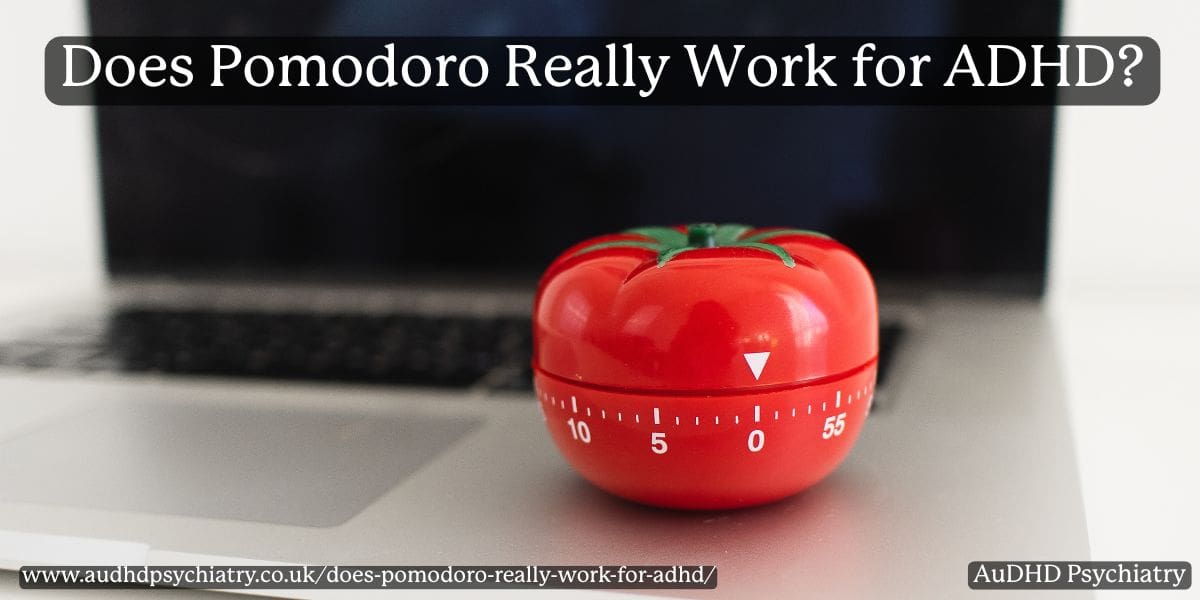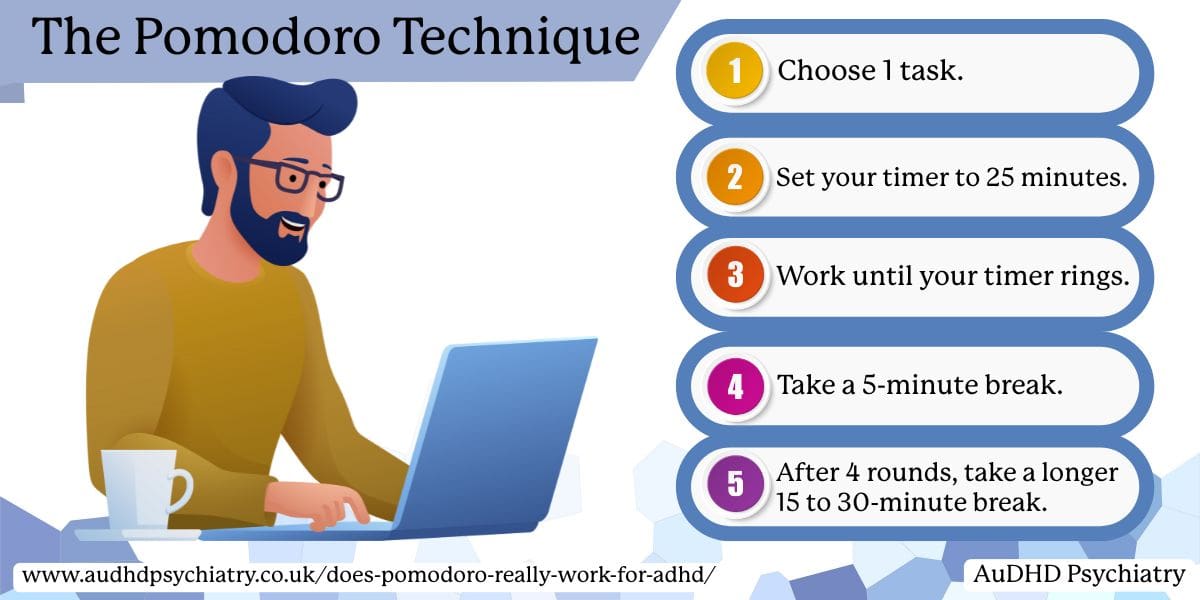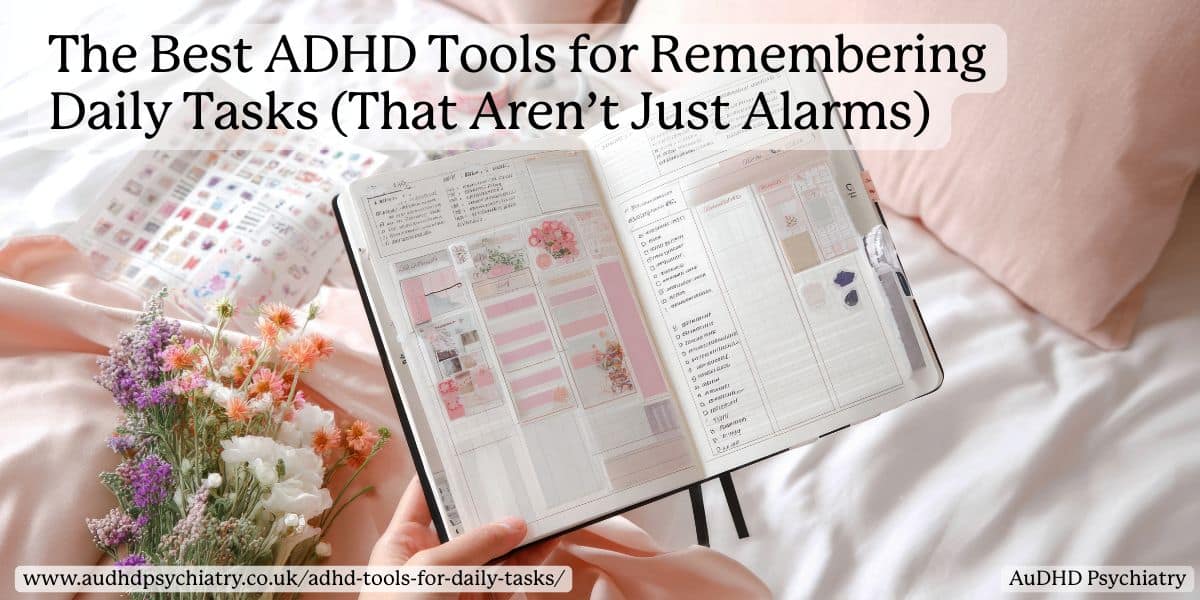
The Pomodoro Technique is often promoted as a helpful tool for those with ADHD who struggle to stay focused, but does it really work, and how? For many people with ADHD, staying focused isn’t a matter of willpower. It’s a neurological challenge. Starting tasks, sustaining attention, and managing time can feel disproportionately difficult, even for simple activities. As a result, many look for structured tools to support productivity.
The Pomodoro is a timed method involving 25-minute work intervals followed by short breaks. It can help reduce overwhelm, improve attention regulation, and provide a sense of progress by breaking tasks into manageable segments. However, its effectiveness varies. While some individuals with ADHD benefit from its external structure, others may find the frequent resets disruptive.
This article explains how the Pomodoro Technique works, when it may support focus, and how to adapt it to suit ADHD-related challenges. We also outline its step-by-step process, other ADHD-specific tools, and possible alternatives.
What Is the Pomodoro Technique?
Francesco Cirillo developed the Pomodoro Technique in the late 1980s. It’s a time management method named after the kitchen timer that is tomato-shaped, which he used as a university student, with “pomodoro” being the Italian word for tomato. The method divides work into timed intervals, usually 25 minutes of focused effort followed by a short five-minute break. These periods are known as Pomodoros.
The core idea is simple: focus on a specific task for a set period, take a short break, then repeat. After four cycles, a longer break of around 15 to 30 minutes is taken. This structured approach aims to maintain mental freshness, support sustained attention, and encourage consistent progress through manageable chunks.
Why It’s Popular
Its popularity lies in its simplicity. Whether you’re using a traditional timer, a visual timer, or a digital Pomodoro app, all you need is a timer and a task list. For individuals who struggle with distraction or mental fatigue, the technique offers a clear start and stop point. It also helps limit multitasking, promoting task completion and improved focus.
Application for ADHD
While originally designed for general productivity, the Pomodoro Technique has gained attention for its potential to support those who have attention deficit hyperactivity disorder (ADHD). For people with ADHD, who often face challenges with time perception, executive functioning, and task initiation, the Pomodoro method can serve as an external structure that reduces cognitive overload. It introduces frequent reinforcement through short breaks, helping to manage motivation as well as energy levels throughout the day.
The repetitive nature of the cycle supports habit-building, which is especially valuable for those who struggle with routine. Additionally, by relying on external timing rather than internal motivation, Pomodoro can provide consistency and reduce the mental load associated with managing long or complex tasks. In these ways, it serves as a useful foundation for developing effective work habits over time.

How Does Pomodoro Work for ADHD?
Some of the symptoms of ADHD are difficulties with attention regulation, executive functioning, and impulsivity. These challenges often affect how individuals plan, initiate, and complete tasks. The Pomodoro Technique introduces a clear time limit, typically 25 minutes, that acts as a visual and auditory cue for starting work. For many, the act of setting a timer helps to bypass task paralysis and encourages immediate action.
Supporting Attention and Regulation
The regular work-break cycle aligns well with the need for frequent stimulation and rest in ADHD brains. Individuals are less likely to experience cognitive fatigue when using short intervals of concentrated effort. The structured breaks reduce overwhelm and create a predictable rhythm that supports sustained attention. Using this approach consistently may also help improve overall time management skills.
Addressing Time Blindness
One of the most useful aspects of Pomodoro for ADHD is its impact on time blindness, the inability to sense how much time is passing. With a timer providing real-time feedback, individuals become more aware of time as a concrete resource. This can reduce underestimation or overestimation of how long tasks will take and improve the ability to plan ahead.
For those struggling with motivation or persistent procrastination, Pomodoro offers a low-pressure entry point. By reframing tasks into small, time-limited sessions, it reduces resistance and makes starting feel more manageable. It also introduces frequent opportunities to reset, which can be particularly helpful for managing fluctuating energy levels or shifting focus. When used alongside other ADHD strategies, such as visual planning tools or accountability check-ins, Pomodoro becomes part of a broader support system.
Why ADHD Brains Struggle with Time and Tasks
ADHD impacts the brain’s executive functions, the mental processes responsible for planning, organisation, and emotional regulation. When these systems are impaired, everyday tasks can feel overwhelming. This often results in task paralysis, where individuals feel mentally stuck and unable to start even simple actions. It is a common experience for those with ADHD and is often misunderstood as laziness or avoidance.
Time Blindness and Inconsistent Motivation
Another hallmark difficulty is time blindness. People with ADHD may find it difficult to estimate how much time a task will take or recognise when time is passing. This can lead to missed deadlines, rushed efforts, or an inability to complete longer projects. Combined with inconsistent motivation, where interest fluctuates unpredictably, this creates a cycle of unfinished work and mounting frustration.
The Role of Structure and External Tools
Breaking large projects into smaller tasks using a structured approach can help. Techniques like Pomodoro offer both visual cues and a sense of urgency, which are especially useful for regulating attention span. By working in short intervals and pausing regularly, individuals can manage their energy more effectively and build productive routines.
Understanding these underlying challenges is essential when choosing a time management method. While Pomodoro may not work for everyone, it directly addresses many of the obstacles faced by individuals with ADHD, including executive dysfunction, poor time perception, and difficulty with task initiation. The technique also promotes a sense of completion and control, both of which are crucial for building self-efficacy.
To learn more about ways to support focus and overcome mental blocks, you may find our article on ADHD and Waiting Mode helpful.
The Pomodoro Effect: Why It Helps With ADHD
One reason the Pomodoro Technique works for many individuals with ADHD is its impact on motivation and reward. ADHD brains often require more stimulation to maintain interest, particularly in tasks that are routine, lengthy, or lacking novelty. The short, timed sessions of Pomodoro introduce a sense of urgency, followed by consistent positive reinforcement through break periods. This rhythm can help stimulate dopamine, a neurotransmitter involved in reward and motivation, offering a small mental “win” with each completed Pomodoro.
Structured Breaks Prevent Burnout
Frequent, scheduled pauses allow for recovery between focus periods. These brief breaks prevent cognitive overload, support emotional regulation, and provide time for movement or relaxation, which are essential for managing ADHD symptoms. By offering short rest periods after each work session, the Pomodoro Technique helps prevent mental fatigue, a common issue in neurodivergent work patterns.
Completing Tasks in Manageable Chunks
Large projects can feel unmanageable for individuals with ADHD. By breaking them down into short intervals, such as four 25-minute focus blocks, the Pomodoro method promotes task completion in smaller, less intimidating stages. This makes it easier to maintain momentum and reduces avoidance behaviours linked to executive dysfunction.
Encouraging Consistent Progress
Pomodoro is particularly helpful in creating steady, repeatable routines. It gives you a structured approach that reduces the decision fatigue often experienced by those with ADHD. When used regularly, it builds a sustainable workflow based on repetition, not willpower.
How to Use the Pomodoro Technique Step-by-Step

Step 1: Choose a Clear Task
Begin by selecting a single, specific task. This helps minimise distraction and supports attention regulation. Writing it down reinforces focus and provides a clear goal for the session.
Step 2: Set Your Timer
Use a timer, whether digital, physical, or visual, and set it for 25 minutes. This period is known as one Pomodoro session. Tools like visual timers or ADHD-friendly apps can help make time feel more concrete, which is especially useful for those who experience time blindness or inconsistent motivation.
Step 3: Focus Until the Timer Rings
During the 25-minute work period, concentrate solely on the task. Avoid checking emails, switching tabs, or multitasking. If distracted, note the interruption and return to the task.
Step 4: Take a Short Break
Once your timer rings, step away from your task and take a 5-minute break. This is essential for maintaining energy and attention across multiple cycles. Get a drink, stretch, or take a quick walk: anything that gives your brain time to reset.
Step 5: Repeat the Cycle
After 4 Pomodoros, go for a longer break, around 15 to 30 minutes. This rest period helps your brain consolidate effort and prepare for further work sessions. This step-by-step approach turns large tasks into manageable chunks, reduces overwhelm, and provides frequent feedback, all of which are especially important for individuals with ADHD.
Troubleshooting Common ADHD Challenges
Task initiation is one of the most common challenges for individuals with ADHD. Even with a timer set, starting a task can feel mentally exhausting. In these cases, reducing the initial Pomodoro session to just five or ten minutes can help build momentum. Starting small creates a mental foothold, lowering resistance and encouraging task engagement without overwhelming the individual.
Another useful approach is to begin with a warm-up task, something low-effort and familiar, before transitioning into a more demanding activity. This can ease the mental barrier of getting started.
Switching Tasks Feels Impossible
Some people with ADHD experience hyperfocus, which makes switching away from a task difficult. When this occurs, try setting a visible break timer to signal transitions. Building in a short transition activity between tasks, such as standing, stretching, or walking, can ease the shift between focus modes and reduce cognitive friction.
It may also help to use auditory cues or gentle alarms that fade in, rather than loud timers that cause stress or confusion. Creating a consistent environment for work and rest also supports smoother transitions.

Distractions Interrupt Every Session
External and internal distractions are common. Using headphones, closing unnecessary tabs, or pairing Pomodoro with body doubling (working alongside someone) can improve concentration. Journaling brief intrusions or using a distraction log can help externalise mental clutter and reduce repetitive task-switching.
Overstimulation From Timers
For some, timers may cause stress or sensory discomfort. Choosing a visual timer with soft alerts or using Pomodoro apps with customisable settings can reduce overstimulation while maintaining structure. Colour-coded timers or devices with vibration functions may also provide useful alternatives.
Tailoring Pomodoro to ADHD Realities
Understanding how to adapt the technique to your environment and cognitive needs is essential. The Pomodoro method is flexible, not rigid, and can be reshaped to work with, not against, your attention style. Tracking which adaptations help most can lead to a more personalised and sustainable routine.
Avoiding Time Management Temptations
The Urge to Extend Work Periods
One of the common pitfalls when using the Pomodoro Technique is the temptation to keep working past the 25-minute limit. While it may feel productive in the moment, extending work sessions can lead to burnout and reduce long-term efficiency. For individuals with ADHD, adhering to the set work intervals is vital for maintaining consistent energy levels and supporting the brain’s natural need for regular stimulation and rest.
Longer stretches of unbroken concentration can also increase the risk of hyperfocus, making it harder to shift attention when necessary. By sticking to shorter, defined sessions, users allow their brains to reset and return with renewed focus. This supports better attention regulation and reduces the build-up of mental fatigue over time.
Taking Breaks That Actually Help
Breaks are a critical part of the Pomodoro Technique, but they need to be intentional. Many people use breaks to scroll through social media or check emails, which may feel restful but often increase cognitive load. Instead, breaks should include light physical movement, hydration, or stepping outside for fresh air, examples of activities that help reset the brain and body.
Choosing breaks that suit your attention span and sensory needs can improve overall effectiveness. A structured approach to break time reinforces routine and helps build long-term focus habits. Those with ADHD benefit most from brief breaks that are consistent and low-stimulation, allowing the mind to decompress without becoming distracted.
Handling Interruptions Mid-Pomodoro
Distractions are inevitable, especially in shared or noisy environments. Having a plan for interruptions, such as jotting down the distraction to revisit later, can protect focus. If disrupted, restarting the timer or pausing mindfully can maintain momentum without losing control of the routine.
To support ADHD-friendly environments, consider adapting your workspace or using visual cues to signal active focus time to others. For more practical support, our article on how to manage ADHD in the workplace offers helpful strategies.

Tools and Apps to Support Your Pomodoro Routine
Many individuals with ADHD benefit from tools that provide clear, visual cues about time passing. Visual timers, colour-coded countdown clocks, and apps with custom alerts can all serve as useful external supports. These tools make the abstract concept of time more concrete and reinforce the structure of Pomodoro sessions.
Using a timer that is easy to see and hear can improve consistency and reduce reliance on internal time tracking, which is often impaired in ADHD. For some, tactile timers or timers with vibration features are more suitable, particularly for sensory-sensitive users.
ADHD-Friendly Digital Apps
There are several Pomodoro apps designed with ADHD users in mind. These may include features like flexible session lengths, soothing soundscapes, or built-in to-do lists. Many also integrate with calendar systems to allow for more complex scheduling. Apps like Focus To-Do, Forest, and Pomodone offer adjustable settings that accommodate different attention spans and work styles.
While digital tools are helpful, it is essential to avoid feature overload. Simple interfaces with clear functions are often most effective for ADHD users. Reducing visual clutter and focusing on the core Pomodoro cycle improves usability and long-term adoption.
Planners and Printable Resources
For those who prefer physical tools, printable Pomodoro planners and ADHD workbooks can help reinforce structure. These resources allow individuals to track focus intervals, log distractions, and plan longer projects in smaller, actionable steps. Some planners are specifically tailored for individuals with ADHD and include prompts for energy tracking and goal setting.
Find more of our recommended resources in this article. While these are our topics, it’s essential to consider that selecting tools that align with personal preferences, sensory needs, and the user’s specific work environment will increase the likelihood of success.
Adapting Pomodoro for Kids and Unique Needs
The Pomodoro Technique can also be effective for children with ADHD, particularly when sessions are shortened and made more engaging. Instead of the standard 25-minute interval, younger children may benefit from 10- or 15-minute focus sessions followed by short, structured play breaks. Visual timers, stickers, and clear checklists help maintain interest and promote independence.
Involving Caregivers and Teachers
Support from adults is essential. Teachers can incorporate Pomodoro sessions into the classroom by using group timers or shared goals, which support collective focus. At home, parents can help children manage homework or chores using shared countdown timers and verbal cues.
Caregivers can also assist in modifying break activities. Encouraging a snack, movement break, or time outdoors keeps the break restorative without being overstimulating. For children with high energy, incorporating physical activity into break time can enhance focus in subsequent work sessions.

Adjusting for Teens and Young Adults
Older children and teens may benefit from more autonomy but still require guidance. Allowing them to select their own tasks and break activities can increase engagement. For example, using a Pomodoro app that lets teens customise sound cues or themes might improve buy-in.
Adolescents navigating longer tasks, such as revision or coursework, can learn to break these into smaller steps using the Pomodoro cycle. Teaching them how to assess task length, time needed, and energy levels empowers more effective self-management. Over time, this builds time management skills and confidence.
For families navigating ADHD together, our guide on private ADHD assessments for children can help clarify next steps.
When to Seek Extra Help with ADHD Productivity
While the Pomodoro Technique offers a structured and practical method to manage time, it may not fully address the underlying challenges associated with ADHD for every individual. If you’re consistently struggling with task initiation, missing deadlines despite structured attempts, or experiencing emotional burnout from incomplete projects, it may be time to explore additional support.
Recognising When Pomodoro Isn’t Enough
Signs that the Pomodoro method may not be working include an inability to maintain the routine over time, continued executive dysfunction, or emotional distress related to productivity. In these cases, external strategies such as professional coaching, therapy, or ADHD medication may provide more tailored interventions that address the cognitive and behavioural factors involved in this condition.
Role of ADHD Coaches and Therapists
ADHD coaches can assist with goal-setting, accountability, and personalised strategy development. Their support often focuses on building effective time management, emotional regulation, and long-term routines. For many, coaching for ADHD adults provides practical guidance that bridges the gap between everyday challenges and sustainable productivity habits. Therapists, particularly those experienced in cognitive behavioural therapy (CBT), can also aid individuals to understand the thought patterns and emotional responses that may interfere with focus and productivity.
Combining Pomodoro with professional support allows individuals to adapt the technique within a broader care plan. This approach acknowledges that productivity challenges may stem from a combination of neurological, emotional, and environmental factors, all of which benefit from expert input.
Next Steps and Support Options
If you’ve tested multiple productivity tools and still find yourself falling behind or feeling overwhelmed, a formal ADHD assessment could help clarify your needs. Identifying specific areas of difficulty, such as attention regulation, executive functions, or time perception, allows for more targeted interventions. For those ready to take the next step, our private ADHD assessment in Glasgow provides a structured and professional evaluation that can guide treatment and support options.
Private ADHD support provides quicker access to diagnostic insights, treatment options, and referral pathways for therapy or coaching. If you’re considering professional assistance, AuDHD Psychiatry offers expert support designed for individuals with ADHD, including assessments, coaching, and therapy. Taking this step can lead to a clearer understanding, personalised strategies, and more effective ways to manage daily tasks with confidence.
Conclusion
The Pomodoro Technique offers a simple, structured way to break tasks into focused work sessions and regular breaks. For many individuals with ADHD, it provides external cues that support attention regulation, reduce overwhelm, and improve task completion. However, as with any productivity method, its success depends on how well it aligns with the unique needs of each person.
Throughout this guide, we’ve explored how Pomodoro can be used as a flexible framework, one that can be personalised for children, adults, students, or professionals. We’ve also covered how to handle common ADHD-related challenges by choosing the right tools and recognising when additional support may be needed.
If you’ve found that traditional strategies fall short, remember that personalised help is available. A private ADHD assessment and treatment can offer clarity, personalised recommendations, and a path forward that matches your strengths and needs. Book a call with our team today and take the first step toward building a system that truly works for you.
Learn additional techniques to tackle task paralysis in our detailed post on Simple ADHD-Friendly Techniques to Beat Task Paralysis.
You Might Also Like
Contact Us
We’re here to answer any questions you might have.
Get in Touch
Opening Hours
Contact Form
We’re here to help. Reach out and we’ll get back to you within 24 hours (Monday – Friday).



